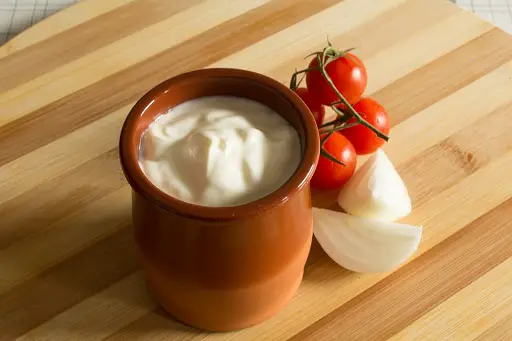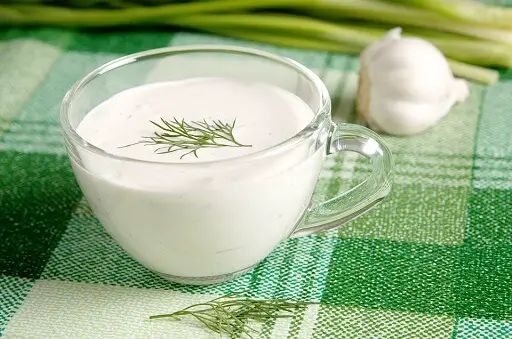Table of Contents
Introduction
Sour cream is a dairy product that is made by fermenting cream with lactic acid bacteria. It has a tangy and slightly acidic flavor, which makes it a popular ingredient in both sweet and savory dishes.
Sour cream is commonly used in dips, dressings, baked goods, and as a topping for dishes like chili and baked potatoes. It is also used in some recipes as a substitute for other dairy products, such as milk or yogurt.
But, did you microwave it before? Were your results successful as you had expected? If the answer is no, let’s keep reading the “Can you microwave sour cream?” article, to find out some cooking tips for the best result!
Can You Microwave Sour Cream?
Sour cream can be microwaved, but it may not retain its texture and consistency very well. When heated, sour cream can become watery, separate or curdle, and lose its smoothness.
If you need to heat sour cream in the microwave, it’s best to do so gradually and in short bursts, stirring between each interval to distribute the heat evenly. This will help prevent the sour cream from overheating and separating.
It’s also worth noting that microwaving sour cream could affect the taste and quality of the food you’re adding it to. In some recipes, it may be better to add sour cream after heating or to use an alternative method of heating.

Risks Of Microwaving Sour Cream
When microwaving sour cream, there are some risks that need to be considered. Here are some of the potential risks associated with microwaving sour cream:
- Bacterial growth: When sour cream is exposed to heat, it creates an environment that is conducive to bacterial growth. This is particularly true if the sour cream is left at room temperature for an extended period before microwaving it. Bacterial growth can cause foodborne illnesses such as salmonella, listeria, and E. coli.
- Curdling: Sour cream may curdle or separate when microwaved. This is due to the heat causing the proteins in the sour cream to denature and coagulate, resulting in a lumpy texture.
- Texture changes: Microwaving sour cream can cause it to lose its creamy texture and become thinner or runnier. This can affect the taste and mouthfeel of the sour cream.
- Nutritional value: Microwaving sour cream can cause a loss of nutrients, particularly vitamin C, which is heat-sensitive and can be destroyed during the microwaving process.
- Chemical changes: Sour cream contains lactic acid, which can react with other compounds in the sour cream when exposed to heat, resulting in chemical changes that can affect the taste and color of the sour cream.
It is important to note that the risks of microwaving sour cream can be mitigated by following proper handling and storage practices and by microwaving it in a safe and careful manner. However, if you have any concerns about the safety of your sour cream, it is always best to err on the side of caution and discard it.
The Way To Use The Microwave To Heat Your Sour Cream
Microwave is a dangerous kitchen appliance, so what happens if you microwave sour cream? It may splash if you don’t heat it correctly!
We highly recommend not using plastic containers when heating because they are unsafe and can release poisonous chemicals during heating time. You can find a ceramic bowl or glass plate or another one allowed to use for the microwave.

Heating sour cream in the microwave can be a bit tricky, as it can easily curdle or separate if overheated. Here are the steps you can follow to heat sour cream in the microwave:
- Transfer the desired amount of sour cream to a microwave-safe dish.
- Use a spoon or fork to stir the sour cream to help distribute the heat evenly.
- Microwave the sour cream on medium power for 15-20 seconds.
- Stop the microwave and stir the sour cream again.
- Repeat steps 3 and 4 until the desired temperature is reached. It’s important not to overheat the sour cream, so be sure to check it frequently and stop microwaving it as soon as it’s heated through.
- Once the sour cream is heated, use it immediately or store it in the refrigerator if not using it right away.
Keep in mind that the exact heating time may vary depending on the amount of sour cream and the power of your microwave, so it’s important to be cautious and check frequently to avoid overcooking.
Should You Reheat Sour Cream With Leftovers?
It’s generally not recommended to reheat sour cream along with leftovers in the microwave or oven as it has a tendency to separate and become watery or grainy when exposed to high temperatures. Instead, it’s best to remove any sour cream from the leftovers before reheating them and add fresh sour cream to the dish after it’s been reheated.
If you really want to reheat leftovers with sour cream, it’s best to do it on the stovetop using low heat and stirring frequently to prevent the sour cream from separating. However, even with this method, there’s still a risk of the sour cream separating, so it’s best to use this method as a last resort.
It’s best to keep sour cream separate from the leftovers until you’re ready to eat them and add it as a garnish or topping after reheating. This will ensure that the sour cream retains its texture and doesn’t affect the overall taste and quality of the leftovers.

Some Of The Sour Cream Microwaving Tips For You!
The tendency is used to blend into various food layers, which is why it is not easy to separate toppings or condiments from the leftovers. One of the quickest shortcuts to reheating your leftovers may be microwaving sour cream.

The main problem you need to note is to be cautious during sour cream microwaving; otherwise, it can be separated or curdle.
Set the low temperature first and heat gradually to the heat level to lessen the coagulation ability.
Below are some tricks for you to microwave your sour cream for these future meal preparation:
- Put the microwave cover or a paper towel over the container to minimize splatter during reheating.
- Leave the sour cream inside the leftovers and add a little more for a cold cream cover on the side.
- Replace the initial plastic container with another used for the microwave.
- For a large amount of sour cream, heat smaller portions step by step.
- Decrease the power to the medium or low level when heating the food.
- Do not reheat once heated sour cream before.
It may be tricky to reheat your favorite meals, including sour cream. Your results may become a soggy mess depending on the content of the sour cream inside.
Handle each dish differently to microwave your leftovers carefully and avoid any coagulation or curdling.
Final Thoughts
We highly recommend that you only reheat your sour creams when it is a part of your leftovers. Please carry on carefully and begin with smaller portions if you will do it yourself.
Besides, remember to follow the progress. Be cautious when heating if you don’t want the result with curdled milk and chunky cream.
Hopefully, you will find the “Can you microwave sour cream?” post insightful and informative. Stay tuned to our next article!
Thank you for reading!
See more tips about microwave here








